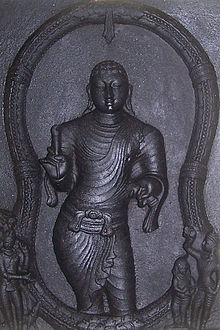
Back Ilango Adigal Spanish Ilango Adigal French इलांगो अडिगल Hindi ಇಳಂಗೋ ಅಡಿಗಳ್ Kannada 일랑고 아디갈 Korean ഇളങ്കോഅടികൾ Malayalam ایلانگو ادیگال PNB Ilango Adigal Romanian இளங்கோவடிகள் Tamil ఇళంగో అడిగళు Tegulu


Ilango Adigal (Tamil: இளங்கோவடிகள், Malayalam: ഇളങ്കോവടികൾ, romanized: Iḷaṅkōvaṭikaḷ) was a monk and a poet, sometimes identified as a Chera prince.[1][2][3] He is traditionally credited as the author of Cilappatikaram, one of the Five Great Epics of Ancient Tamil literature. He is one of the greatest poets from Cheranadu (now Kerala). In a patikam (prologue) to the epic poem, he identifies himself as the brother of a famous Chera king Ceṅkuṭṭuvan (Senguttuvan). This Chera king, as stated by Elizabeth Rosen, ruled over his kingdom in late 2nd or early 3rd century CE.[4][5] However, this is doubtful because a Sangam poem in Patiṟṟuppattu – the fifth ten – provides a biography of Ceṅkuṭṭuvan, his family and rule, but never mentions that he had a brother who became an ascetic or wrote one of the most cherished epics.[6] This has led scholars to conclude that the legendary author Ilango Adikal myth was likely inserted later into the epic.[6][7] In a 1968 note, Kamil Zvelebil suggested that, "this [Adigal claim] may be a bit of poetic fantasy, practised perhaps by a later member of the Chera Dynasty [5th or 6th century[8]] recalling earlier events [2nd or 3rd century]".[4]
- ^ "Who Was Ilango Adigal? – Amar Chitra Katha". www.amarchitrakatha.com. 18 June 2020. Retrieved 13 September 2020.
- ^ Vimala, Angelina (September 2007). History And Civics 6. Pearson Education India. ISBN 978-81-317-0336-6.
- ^ Lal, Mohan (1992). Encyclopaedia of Indian Literature: Sasay to Zorgot. Sahitya Akademi. ISBN 978-81-260-1221-3.
- ^ a b Rosen, Elizabeth S. (1975). "Prince ILango Adigal, Shilappadikaram (The anklet Bracelet), translated by Alain Damelou. Review". Artibus Asiae. 37 (1/2): 148–150. doi:10.2307/3250226. JSTOR 3250226.
- ^ Adigal 1965, p. VIII.
- ^ a b Iḷaṅkōvaṭikaḷ; R Partaasarathy (2004). The Cilappatikāram: The Tale of an Anklet. Penguin Books. pp. 6–8. ISBN 978-0-14-303196-3.
- ^ Gananath Obeyesekere (1970). "Gajabahu and the Gajabahu Synchronism". The Ceylon Journal of the Humanities. 1. University of Sri Lanka: 44.
- ^ Kamil Zvelebil 1973, pp. 174–176.
© MMXXIII Rich X Search. We shall prevail. All rights reserved. Rich X Search